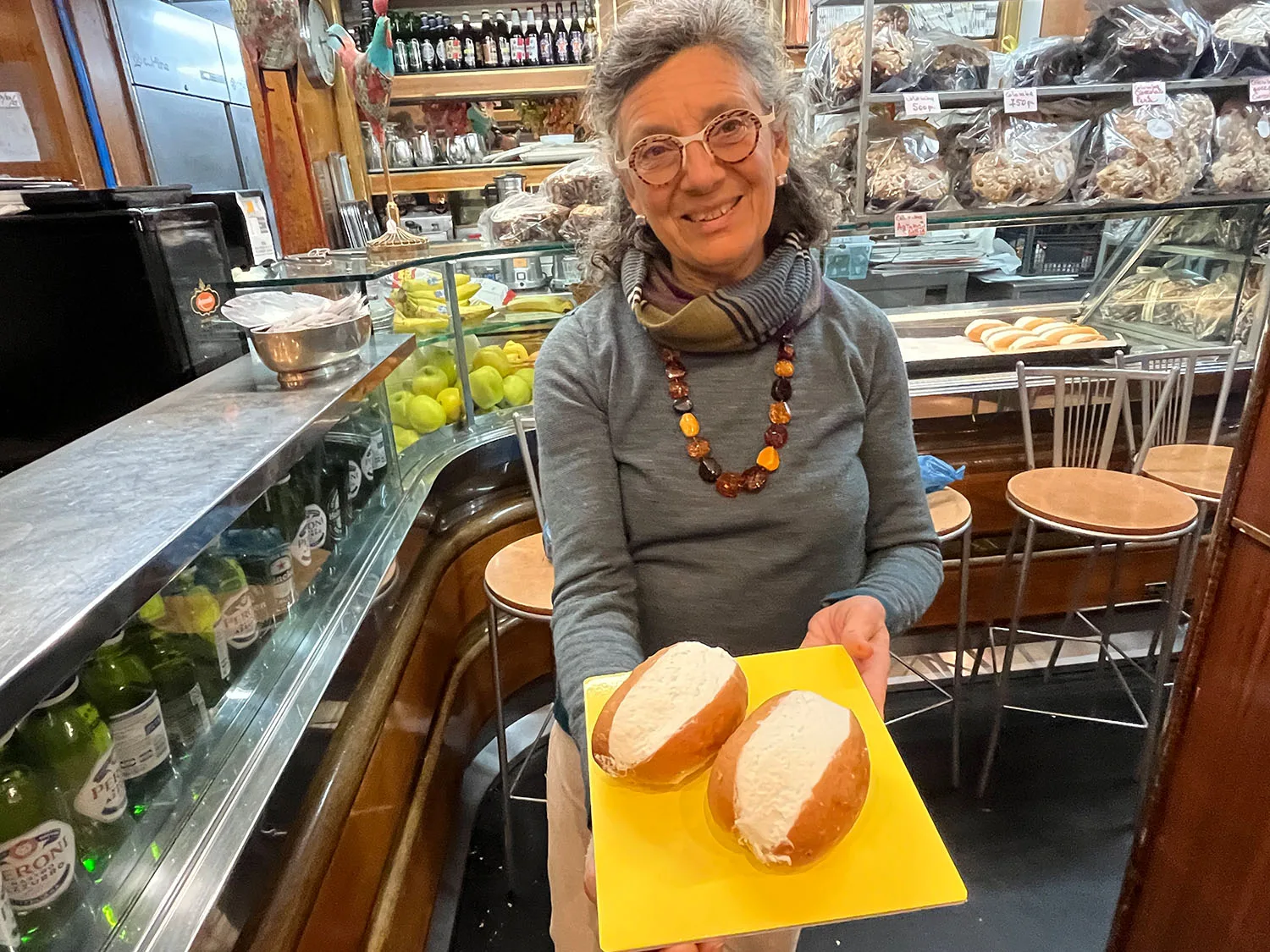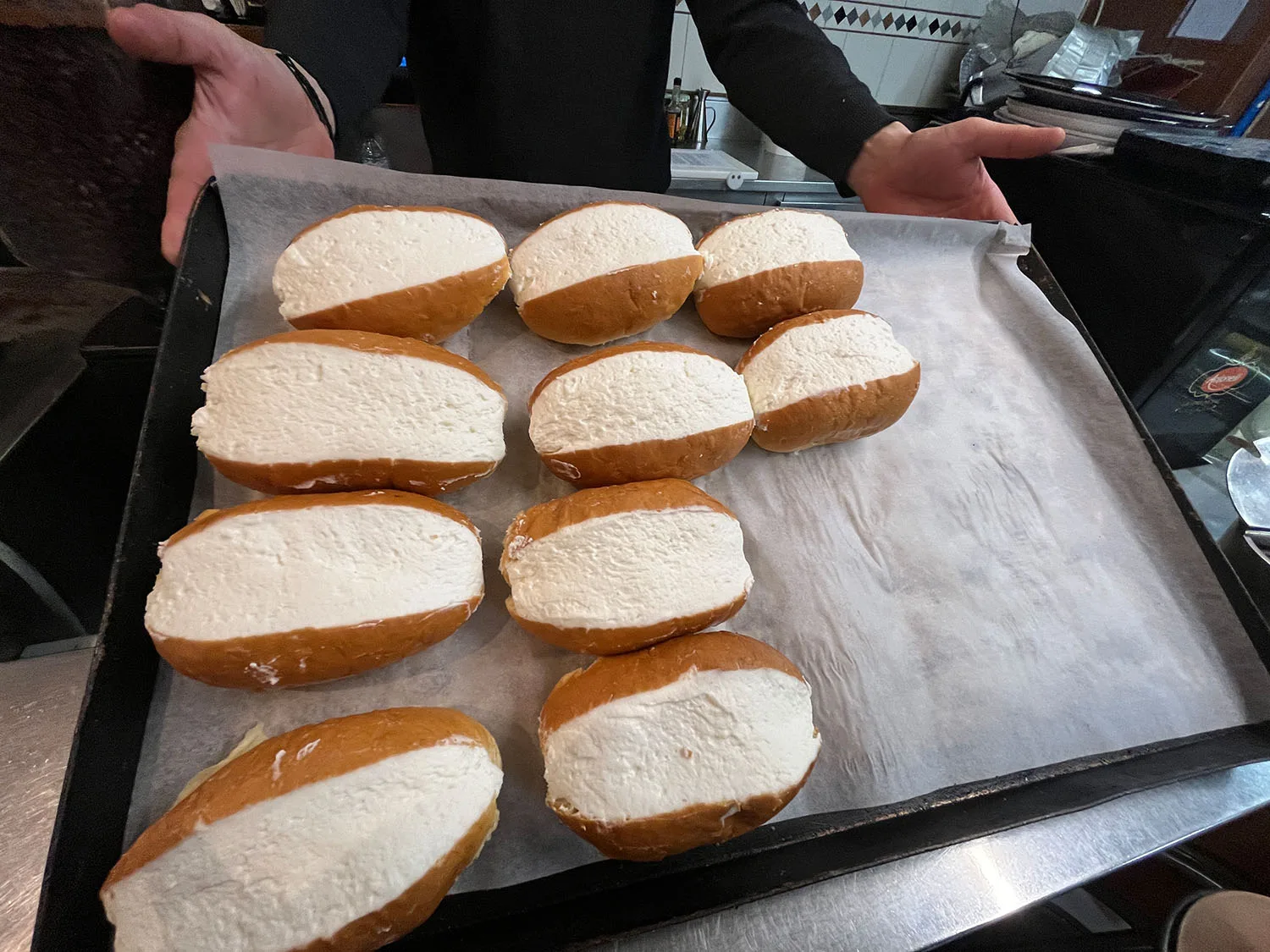La cucina Romana boasts a legacy of savoury dishes ranging from smoky guanciale-laced pastas to the iconic carbonara and abbacchio – juicy, rosemary-scented lamb. When it comes to desserts, however, one confection stands out as the city’s favourite: formerly reserved for breakfast, nowadays the maritozzo is an all-day indulgence.
Cinzia Romoli, third-generation owner of Pasticceria Romoli (located in Rome’s residential African Quarter and must-stop on the maritozzi trail), explains that for years, Roman Jewish cuisine dominated the dessert scene. People still line up daily at historic bakery Boccione in the Jewish Ghetto for a slice of tangy cherry and ricotta crostata, or pizza ebraica, a brioche-like bun filled with toasted nuts, dried fruit, marzipan and candied ginger. Maritozzi, on the other hand, she says, are quintessentially Roman, with roots planted firmly in the ancient empire that gave the city its name.
Most often referred to in the plural (to be fair, it’s hard to eat just one), maritozzi begin with a fresh and fluffy brioche bun that is then sliced down the middle and filled with ever-so-slightly sweetened whipped cream. Maritozzi are practically a symbol of the city, and like all things Roman, they’re cloaked in legend – in this case, a very sweet one.

[Photo: Pasticceria Romoli, courtesy of Annie B. Shapero]
What’s In A Name
Maritozzo derives from the Italian word for husband, marito. As culinary legend has it, ancient Roman women used to send their husbands off to the fields with a precursor to today’s brioche: a simple yet filling bun made from flour, eggs, water, salt, honey and raisins.
Sometimes referred to as er santo maritozzo (the holy maritozzo), during the Mediaeval period, this beloved sweet bread called pagnottella was the only confection allowed during Lent, when observant Christians rid their homes of flour and sugar. A Lenten version still exists today, made with olive oil in place of butter and topped with pine nuts, raisins and candied citrus.
Love, Sweet Love
Also known as maritelli, panmariti and panpariti, ‘marito’ remains at the root of the word. Roman poets of the 19th and 20th centuries frequently referenced a tradition wherein a male companion would give his lady friend the cream-filled brioche with an engagement ring or a piece of gold hidden inside. Luigi Antonio Gioacchino Zanazzo, a poet and anthropologist who studied Roman language and culture specifically, described the brioche decorated in hearts, clasped hands and cupid arrows.
Other theories claim that women in search of a marriage proposal would present heart-shaped pastries to prospective husbands. Whoever baked the tastiest one would snag him.
Romoli confirms that the tradition holds strong. She’s witnessed dozens of successful proposals and heard about hundreds; some of her customers have even accompanied their pastry proposals with a serenade. She also prepares entire platters of them for weddings, known as torta maritozzo and served in place of cake.
Sweet Endings & Savoury Snacks
The dessert has since spread throughout central and southern Italy. In Marche it’s invariably topped in pine nuts, whereas a braided version of the brioche appears throughout Puglia and Sicily.
The classic maritozzo still reigns in Rome, but bakeries like Romoli are experimenting with double fillings, such as pastry cream and pistachio, Chantilly and strawberry, and even tiramisu.
Romoli has also created a line of savoury mini maritozzi filled with classic Roman flavours including oxtail, crunchy puntarella salad, salt cod with pine nuts and raisins, and concia, marinated zucchini – a classic side dish of Roman Jewish origin. A tiny restaurant in Trastevere, Il Maritozzo Rosso also serves a variety of hearty versions stuffed with slow-roasted duck, lamb and octopus.
Where To Find Maritozzi
Maritozzi are ubiquitous in the Eternal City, but Romoli and Regoli – a century-old, family-run pasticceria found just off Piazza Vittorio – top the charts. Both are so well-known they’re practically synonymous, but never competitive. Cinza Romoli once received a call from Regoli that a customer had shown up to collect a maritozzi order he’d placed with her: “There’s no envy between us,” she says. “We admire those who do it right.”

[Photo: Pasticceria Romoli, courtesy of Annie B. Shapero]
Also popular is Roscioli, which still turns out a very popular maritozzo at Roscioli Caffé, near Campo de’ Fiori, and has a chic outpost in New York City’s SoHo district.
Maritozzi are meant to be devoured in the moment, but Romoli says it’s possible to travel with them. Many of her customers have delivered them to family throughout Europe or to kids studying abroad. She’s developed a flash-freezing system to maintain freshness, allowing Romoli maritozzi to reach happy hands as far away as Japan and the USA.
Make Your Own Maritozzi
When it comes to preparing maritozzi at home, Carlo and Laura of Pasticceria Regoli echo Cinzia, who emphasises the quality of the ingredients: “It may seem like a simple recipe,” she says, “but there’s a reason customers line up outside our doors.” High-quality untreated flour, subtle aromas and ultra-fresh eggs and cream make a difference.
The simplicity is key. “Once you start to overcomplicate things or go too gourmet or cerebral, there’s a distacco, a detachment,” she explains. Indeed, classic recipes like the maritozzo are beloved for their familiar flavours.
Start with a basic brioche recipe and flavour the dough with seeds from a vanilla pod, along with lemon or orange zest. The longer the leavening, the fluffier the bread; an hour and a half should be sufficient.
While the buns are baking, whip fresh cream, adding sugar to taste. The filling shouldn’t be overly sweet, as the brioche also has a delicate glaze baked in.
Refrigerate the cream, and cool the buns to room temperature. Slice them lengthwise and stuff them to your heart’s content with cream. There’s no such thing as too much!














Sorry, the comment form is closed at this time.